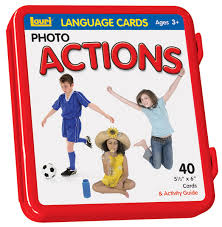When working with a student who is just acquiring language, we spend a lot of time teaching how to answer questions. “What does a dog say?” “What’s your name?” “What’s this?” “What do you do with a shoe?” The answers to these questions are often simple 1-word answers, which is a great place to be for a child just learning language. However, as a child’s language skills develop, we want to encourage them to increase their response length and also to respond to statements like, “Tell me about your day.” Expanding language skills should be paramount in any great ABA program.
If your student is struggling with language at the 1-word level, then that is the place to stay. We would encourage expanding their repertoire of 1-word labels and requests that are understandable before increasing their phrase length. However, for a student who is ready, this is how we would teach it.
Pre-Requisite Skills
Before moving on to 2-word phrases, the student should be able to:
- Request with varied 1-word requests
- Mastered receptive and expressive labels
- Able to tact basic functions (eg: “What do you eat?” and “What do you do with an apple?”)
- Label verbs in both actions and pictures (eg: “swimming”)
- Colours and other basic attributes (eg: big/small)
Verb + Noun
Once a child has mastered labels of verbs, this is a good place to start expanding language. Using the mastered cards for teaching verbs, change the instruction to “Tell me about the picture” and prompt the student to label the card with the verb and the noun. For example: “Kicking ball” or “Eating pizza”. Once this is mastered and the student has learned pronouns (or at least “boy/girl”), you can further expand on the pictures with “Boy eating pizza”. At this point, we usually don’t insert articles because they are an unnecessary increase in phrase length and just confuses many of our students.

Attribute + Noun
If the student is able to label colours, this is also a good place to begin to extend phrase length.
- Hold up an item and ask, “What is it?”
- Child labels the item (eg: “block”)
- Ask, “What colour?”
- Child labels the colour (eg: “red”)
- Then ask, “Say the whole thing”
- Child answers, “Red block”
Labels with “I see…” or “I have…”
As language expands, we want to teach conversation skills as well. Most of our natural conversation is in the format of comments, not questions. Our kiddos are often so used to only responding to questions that comments do not always elicit a response. We can teach a child to have a reciprocal conversation using phrases like “I have…” or “I see…”. With each of you holding an item, the therapist can start with “I have a ball”. Using least to most prompting (text/verbal prompt), the child can learn to reciprocate a comment by labelling what he is holding with “I have a car”. The idea is for the two items to be different so that the child isn’t merely echoing what the therapist said.
Watch our YouTube video here!
Read Part 2 of this blog post here!

